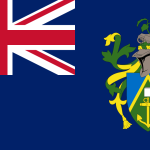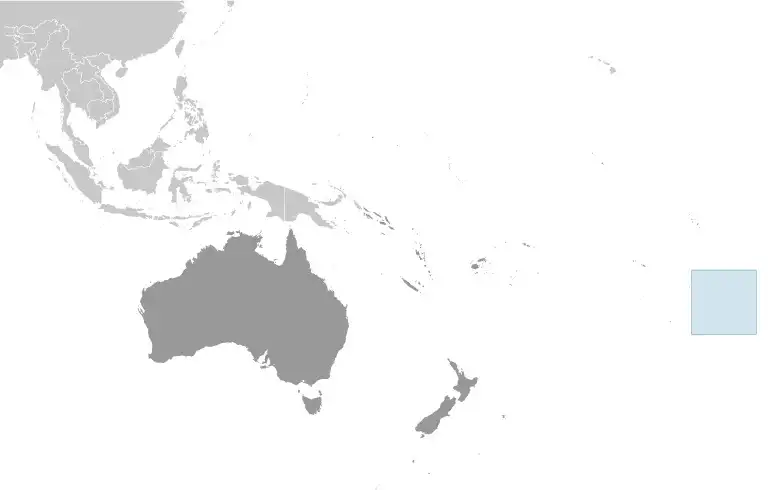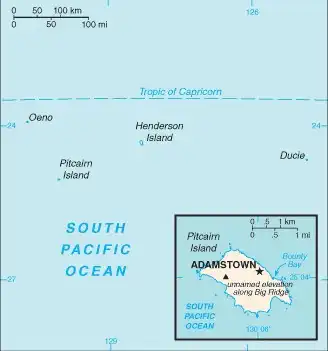
Pitcairn Islands
Veröffentlicht: 20. June 2022 - Letztes Update: 28. February 2025
Country Data Dashboard

Population
50 (2021 est.)
Growth: 0% (2014 est.)
GDP
no data
Area
47 sq km
| Government type: | parliamentary democracy |
| Capital: | Adamstown |
| Languages: | English (official), Pitkern (mixture of an 18th century English dialect and a Tahitian dialect) |
People & Society
Ethnicity
Religion
Age structure
No image available.
Economy
Economic overview
small South Pacific British island territorial economy; exports primarily postage stamps, handicraft goods, honey, and tinctures; extremely limited infrastructure; dependent upon UK and EU aid; recent border reopening post-COVID-19
Real GDP (purchasing power parity) in Billion $
no data
Real GDP per capita in $
No data
Top 5 Import Partner in 2022 (100%)
Top 5 Import Commodities in 2022
- raw copper 🟧🪙
- refined copper 🟧🪙
- cobalt oxides and hydroxides 🪙
- corn 🌽
- soybean meal 🫘🍲
Top 5 Export Partner in 2022 (100%)
Top 5 Export Commodities in 2022
- fertilizers 💩
- sulfur 🧪
- refined petroleum ⛽
- excavation machinery ⚙️
- ethylene polymers 🧴
Geography
Map

Area
Natural resources
- miro trees (used for handicrafts) 🌲
- fish 🐟
Climate
tropical; hot and humid; modified by southeast trade winds; rainy season (November to March)
Historical Background Information
Polynesians were the first settlers on the four tiny islands that are now called the Pitcairn Islands, but all four were uninhabited by the time Europeans discovered them in 1606. Pitcairn Island -- the only one now inhabited -- was rediscovered by a British explorer in 1767. In 1789, Fletcher CHRISTIAN led a mutiny on the HMS Bounty, and after several months of searching for Pitcairn Island, he landed on it with eight other mutineers and their Tahitian companions. They lived in isolation and evaded detection by English authorities until 1808, when only one man, 10 women, and 23 children remained. In 1831, with the population of 87 proving too big for the island, the British attempted to move all the islanders to Tahiti, but they were soon returned to Pitcairn Island. The island became an official British colony in 1838, and in 1856, the British again determined that the population of 193 was too high and relocated all the residents to Norfolk Island. Several families returned in 1858 and 1864, bringing the island’s population to 43, and almost all of the island’s current population are descendants of these returnees.
The UK annexed the nearby uninhabited islands of Henderson, Oeno, and Ducie in 1902 and incorporated them into the Pitcairn Islands colony in 1938. The population peaked at 233 in 1937 as outmigration, primarily to New Zealand, has since thinned the population. Only two children were born between 1986 and 2012, and in 2005, a couple became the first outsiders to obtain citizenship in more than a century. Since 2013, the Pitcairn Islands has tried to attract new migrants but has had no applicants because it requires prospective migrants to front significant sums of money and prohibits employment during a two-year trial period, at which point the local council can deny long-term resident status.
The UK annexed the nearby uninhabited islands of Henderson, Oeno, and Ducie in 1902 and incorporated them into the Pitcairn Islands colony in 1938. The population peaked at 233 in 1937 as outmigration, primarily to New Zealand, has since thinned the population. Only two children were born between 1986 and 2012, and in 2005, a couple became the first outsiders to obtain citizenship in more than a century. Since 2013, the Pitcairn Islands has tried to attract new migrants but has had no applicants because it requires prospective migrants to front significant sums of money and prohibits employment during a two-year trial period, at which point the local council can deny long-term resident status.
